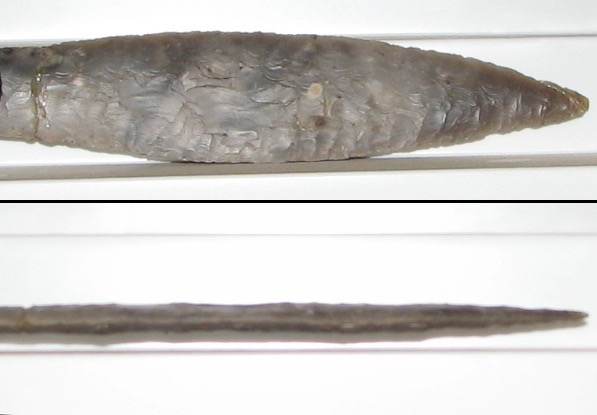October 28th, 2012
Trade goes back a long way. It’s earliest form was “diffusive trade”, by which neighbors traded with each other. Here’s a flint leaf-bladed knife with an interesting story:

This thing was made in Denmark about 4,000 years ago. If you know anything about flint tools, you have already noted the absurdity of this tool. It’s utterly useless. The flint is too thin for you to use this knife for anything; it will break the first time to you try to cut something with it. So why in the world would anybody make such a ridiculous knife? Here’s the answer:

This is a bronze knife from eastern Persia, made a bit more than 3,000 years ago. It’s not as old as the Danish flint knife, but they had such bronze knives in the Middle East at least 5,000 years ago. Many of them were leaf-shaped like the flint knife; this conserved precious bronze.
You can well imagine that such bronze knives impressed the hell out of the Stone Age peoples around the periphery of the civilized Middle East, and as such would be valuable trade items. We can therefore conclude that bronze knives like this one began diffusing out from the Middle East as one Stone Age chieftain traded an extra bronze knife to a more distant Stone Age chieftain. Such trade was not carried out by long-distance traders; instead, neighbor traded with neighbor, and the knives slowly worked their way outward from the Middle East. It’s obvious that a very few such bronze knives had reached Denmark by 2,000 BCE. They would obviously be tokens of high prestige. So what’s a poor chieftain to do if his neighbor is strutting around with his bronze knife and our chieftain has none? He makes the finest possible flint knife to show off, shaped just like the bronze knife. Of course, the flint kinds broke easily, which is why you can see repairs at the base and tip of the flint knife above.
So trade was opportunistic rather than deliberate. And it was not undertaken for profit; instead, ancient rulers practiced trade as a form of diplomacy. You sent some nice gifts to the neighbors to demonstrate your good will, they reciprocated, and you thereby avoided war. But overland trade was terribly slow and inefficient. Your ambassador with his gift would need an armed escort, which would plod along on foot, taking weeks or months to reach their destination. Accordingly, your gifts had to be small, light, and precious: jewels, resins, gold, that kind of thing. Trade back then was not a significant economic factor.
The development of boats made a big change: you could now transport lots of stuff fast and cheaply, so long as it was going downriver. Going upriver was another matter, so you still couldn’t engage in much actual trade. You could receive from the people upstream, but you couldn’t give much in return. Nevertheless, this proved to be useful in both Mesopotamia and Egypt. Have you ever noticed that the earliest cities along the Euphrates, Tigris, and Nile rivers were all pretty far downstream? The pyramids are all downstream from the quarries that provided the stones for the pyramids.
The Egyptians were probably the first to engage in deliberate overseas trade, and the reason was cedar. It’s a superior construction material because it’s easy to cut, lasts forever, yet is quite strong. Cedar didn’t grow in Egypt, it grew in what is now Lebanon. The only practical way to get it from Lebanon to Egypt was by ship. What started out as trivial gift-giving quickly expanded as the Pharaohs realized the usefulness of cedar. They traded a miscellany of goods, mostly manufactured stuff, for the cedar. By 2,000 BCE, there was a steady stream of ships moving cedar to Egypt.
Of course, one ship didn’t carry much cedar. Ships back then were pretty small, perhaps 50 tons. They were propelled by oar power, which meant that they had to have a large crew of rowers, as well as all the food and water they’d need for the trip. When you consider how clumsy these ships were, it’s hard to imagine one carrying more than a handful of cedar logs – which in turn implied the use of a LOT of these little ships.
Of course, seaborne trade was going on all over the Mediterranean by this time, but the ships were too small to be carrying big loads; the trade was still limited to fairly valuable stuff, certainly not anything as cheap as grain. Most shiploads carried ingots of copper, tin, or bronze; perhaps some gold or silver; wine, spices, incense, or valuable manufactured stuff. Again, this trade had little impact on the overall economic well-being of the trading partners; it was, for the most part, vanity stuff for the ruling classes.
But people were slowly learning how to make bigger and more seaworthy ships, and sailors were learning the tricks and tips of navigation. Things were getting better. Along came the Minoans.
